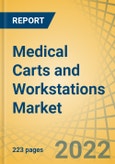Medical Carts and Workstations Market by Product [Mobile Computer Carts (Telemedicine, Powered, Documentation), Medical Carts, Medication Carts, Wall Arm, and Medical Storage Cabinet], End User [Hospital, LTC, Clinics], and Geography - Forecast to 2029Medical Carts and Workstations Market Worth $11.48 Billion by 2029
The medical carts and workstations market is expected to grow at a CAGR of 14.2% during the forecast period 2022-2029 to reach $11.48 billion by 2029.
With extensive secondary and primary research and in-depth analysis of the market scenario, the report carries out the key industry drivers, restraints, challenges, and opportunities. Integration of IT solutions in the healthcare and adoption of EMR/EHR, striving to enhance patient care, safety, and staff productivity are the main driving factors. However, factors such as the high cost of carts or workstations, lack of skilled professions, and maneuvering high workstations are the challenging factors restraining the growth of this market to a certain extent. Furthermore, factors such as a huge untapped market and the adoption of changing ergonomics and advanced designs for carts/workstations offer significant growth opportunities for the market players during the forecast period.
Based on product, the mobile computing carts/workstations segment is estimated to account for the largest share of this market in 2022. The large market share of this segment is attributed to the technological developments made in carts like powered carts having battery-operated systems consisting of a lithium iron phosphate battery or telemedicine carts for efficient workflow, the inbuilt software which helps in fleet management, and advanced ergonomic designs. Furthermore, the outbreak of COVID-19 disease resulted in the growth of telemedicine carts due to social distancing & primary precautions to be followed during the pandemic.
Based on end user, hospitals are widely adopting medical carts & workstations as they help the staff by facilitating recording, storing, and dispensing equipment, supplies, and patient information. Therefore, the hospitals segment is estimated to hold the largest share of the medical carts and workstations market in 2022. Moreover, the carts/workstations comprise compartments, a set of drawers, trays, and sanitizer holders, which are useful in hospital and medical settings. The increasing number of outpatients for infectious diseases like the recent outbreak of coronavirus disease, increasing hospital expenditures, growing technological advancement, and use of telemedicine in hospitals drive the growth of this market for the hospitals segment.
An in-depth analysis of the geographical scenario of the medical carts and workstations market provides detailed qualitative and quantitative insights about the five major geographies - North America, Europe, Asia-Pacific, Latin America, and the Middle East & Africa, along with the coverage of major countries in each region. North America is estimated to command the largest share of the medical carts and workstations market in 2022, followed by Europe, Asia-Pacific, Latin America, and the Middle East & Africa.
Some of the key players operating in the medical carts and workstations market are Midmark Corporation (U.S.), The Harloff Company (U.S.), Capsa Healthcare (U.S.), Bergmann Group (U.S.), Altus Inc. (U.S.), Enovate Medical (U.S.), Medion Healthcare Pvt. Ltd. (India), AMD Global Telemedicine (U.S.), Howard Industries, Inc. (U.S.), Lakeside Manufacturing, Inc. (U.S.), HAT Collective (U.S.), GlobalMedia Group, LLC. (U.S.), JACO, Inc. (U.S.), AFC Industries (U.S.), Bytec Group Limited (U.K.), Parity Medical (U.K.), Solaire Medical, LLC (U.S.), ITD GmbH (Germany), Ergotron, Inc. (U.S.), Herman Miller, Inc. (U.S.), Omnicell, Inc. (U.S.), InterMetro Industries Corporation (U.S.), Medline Industries, Inc. (U.S.), and Modernsolid Industrial Co., Ltd. (Taiwan).
Scope of the Report:
Medical Carts and Workstations Market, by Product
- Mobile Computing Carts/Workstations
- Computer Carts/Workstations
- Powered Computer Carts
- Non-Powered Computer Carts
- Telemedicine Carts/Workstations
- Medication Carts/Workstations
- Documentation Carts/Workstations
- Mobile Computing Carts/Workstation Accessories
- Medical Carts
- Emergency Carts
- Procedure Carts
- Anesthesia Carts
- Wall Mount Workstations
- Wall Arm Workstations
- Wall Cabinet Workstations
- Wall Mount Carts/Workstation Accessories
- Medication Carts
- Medical Storage Columns, Cabinets, and Accessories
Medical Carts and Workstations Market, by End Users
- Hospitals
- Long Term Care Facility
- Physician Offices/Clinics
- Other End Users
Medical Carts and Workstations Market, by Geography
- North America
- U.S.
- Canada
- Europe
- Germany
- France
- U.K.
- Italy
- Spain
- Rest of Europe (RoE)
- Asia-Pacific (APAC)
- Japan
- China
- India
- Rest of APAC (RoAPAC)
- Latin America
- Middle East & Africa
Table of Contents
1. Introduction
2. Research Methodology
4. Market Insights
5. Global Medical Carts and Workstations Market, by Product Type
6. Global Medical Carts and Workstations Market, by End User
7. Medical Carts and Workstations Market, by Geography
8. Competitive Landscape
9. Company Profiles (Business Overview, Financial Overview, Product Portfolio, Strategic Developments)
10. Appendix
Companies Mentioned
- Midmark Corporation
- Capsa Healthcare
- Bergmann Group
- The Harloff Company
- Ergotron Inc.
- Altus Industries
- Enovate Medical
- ITD GmbH
- AMD Global Telemedicine Inc.
- Lakeside Manufacturing Inc.
- HAT Collective
- Parity Medical
- GlobalMedia Group LLC.
- JACO Inc.
- AFC Industries Inc.
- Solaire Medical LLC
- Bytec Group Limited
- Herman Miller Inc.
- Omnicell Inc.
- Modernsolid Industrial Co. Ltd.
- Medline Industries LP.
- InterMetro Industries Corporation








